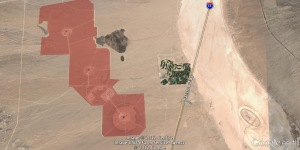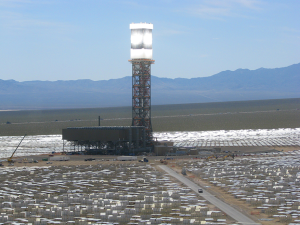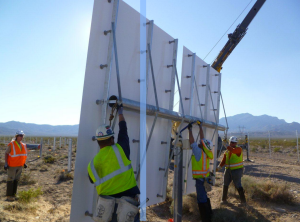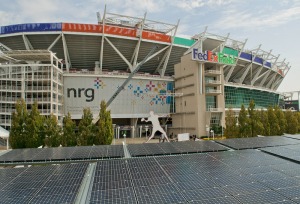When you think of the Mojave Desert, two words likely come to mind – dry and hot as well as images of Joshua trees, sand dunes, and the barren aptly named Death Valley. As of last year, you can now add a sea of glimmering solar mirrors to that list. Make that a sea of more than 300,000 glimmering solar mirrors that make up the world’s largest solar thermal plant. The Mojave Desert is now home to the Ivanpah Solar Electric Generating System which began commercial operation in 2013 and has been harnessing the energy of the desert sun to power homes in Southern California and reduce the state’s carbon footprint. The clean electricity produced by the 392 megawatt solar thermal power project is also helping the state known for it’s highways and traffic congestion avoid millions of tons of carbon dioxide (CO2) and other air pollutants, an equivalent to taking more than 70,000 cars of the road annually.

The three units of the Ivanpah Solar Electric Generating System.
(Credit BrightSource Energy)
In addition to being the largest solar thermal plant in the world, the Ivanpah Solar Electric Generating System has also achieved another first. It received the 2014 Power Magazine’s Plant of the Year award, making it the first renewable energy plant to receive the honor.
The world’s largest solar thermal plant became a reality thanks to a collaborative public/private partnership between the United States Department of Energy, the U.S. Department of the Interior Bureau of Land Management, NRG, BrightSource Energy, Bechtel, and Google. A true testament to how these two sectors can come together on common ground to support the greater good of advancing renewable energy in our country.
Today, we kick off our annual series on BIG projects hearing from Jeff Holland, Director of Communications for NRG, the project’s owner. He fills us in on the vision and goal for the Ivanpah Solar Electric Generating System, how stakeholders and the world were kept informed of the project’s progress and the plant’s operations and economic benefit. We welcome his insights.
– – –
The Ivanpah Solar Electric Generating System came to fruition through a collaboration of multiple corporate partners. Who were these players and what did they each bring to the table?
With NRG Energy’s leadership as the project owner, equity partners Google and BrightSource Energy and Bechtel’s engineering and construction expertise, the team set a new standard for solar thermal power. At the same time, we’re strengthening the nation’s economy and solar supply chain, as well as helping to shift our country closer to energy independence.
What was the overall vision and goal of the Ivanpah Solar Electric Generating System?
The goal was for Ivanpah to become the world’s largest concentrated solar power (CSP) facility, an engineering marvel that increases America’s supply of renewable energy and one that produces clean, reliable solar electricity that will power more than 140,000 homes through California’s two largest utilities—Pacific Gas & Electric (PG&E) and Southern California Edison (SCE). Ivanpah is a magnificent example of a public/private partnership to bring more renewable energy to our country.

Credit: A Google Earth image of the Ivanpah Solar Electric Generating System adjacent to the Ivanpah dry lake bed.
(Credit: Mojave Desert Blog)
What was the rationale behind locating the solar electric plant on the Ivanpah dry lakebed? Can you describe the environmental considerations behind this choice?
This is land leased to us by the Bureau of Land Management and the lease agreement dictates that we return the land to its previously undisturbed state once the power purchase agreements expire.
As part of our ongoing environmental mitigation efforts, we are working with the appropriate state, federal and local agencies to apply science in our mitigation efforts on a wide range of carefully constructed wildlife and biological protection plans.
While we take the work we are doing very seriously and are putting the measures in place and spending the money on monitoring efforts, it is important to note that, climate change is by far the largest threat to life on earth and we have spent billions of dollars on projects like Ivanpah in our quest to find ways to provide clean, sustainable and renewable energy.
Please describe the general design of the plant and how these design standards contributed to a more sustainable project?
Ivanpah uses software to control hundreds of thousands of tracking mirrors, known as heliostats, to directly concentrate sunlight onto a boiler filled with water that sits atop a tower. When the sunlight hits the boiler, the water inside is heated and creates high temperature steam. Once produced, the steam is used in a conventional turbine to produce electricity. Using this concentrated solar thermal technology.

The Ivanpah Solar Electric Generating System begins operation.
(Credit: BrightSource Energy)
Was any outreach conducted to engage stakeholders in the Mojave Desert area?
Of course. NRG is 100% committed to working with the communities in which we operate, and to protecting the health and safety of people, wildlife, plant life, and ecosystems in the areas in which we work.
How did you communicate the project’s progress to the rest of the world. Which communication tools did you find most effective?
We conducted community outreach by attending and speaking at various community-focused events and public hearings as well as direct mail campaigns and developing a project website where people could learn about the progress and gather information on the project’s milestones and accomplishments. We worked with the state and federal groups in developing and reporting all plans to the California Energy Commission who also continue to publish all of our information onto their own website where people can opt-in for updates as well.
Were there any challenges or barriers to receiving public support for the project? If so, how did you overcome these challenges or barriers?
We have worked closely with state and federal agencies and all relevant stakeholders from the moment we began our development of Ivanpah to responsibly address the challenges unique to Ivanpah’s size, location and technology.
As part of our ongoing environmental mitigation efforts, we are working with the appropriate state, federal and local agencies to apply science in our mitigation efforts on a wide range of carefully constructed wildlife and biological protection plans.
I think the public overwhelmingly supports clean energy projects such as Ivanpah when you factor in that it prevents the emission of 400,000 tons of carbon into the atmosphere – tantamount to removing 72,000 cars from California’s roads annually.

Construction workers secure a heliostat onto a pylon.
(Credit: BrightSource Energy)
Construction of the Ivanpah Solar Electric Generating System required thousands of workers. How many people are currently employed by the plant?
At peak construction we employed more than 2,600 people on-site. The project now has 65 employees responsible for the day-to-day operations of the facility. The project also employs 25 biologists for protection and support of wildlife in addition to performing other biological work for the project. At the height of our work, we employed as many as 160 biologists on-site for our Head Start program for desert tortoises. The project provided a local infusion of $300 million in state and local tax benefits at a time when the US economy was going through the “Great Recession” and was in much need of good paying jobs. Total construction wages paid eclipsed $250 million and total employee earnings over the course of the project are expected to be more than $650 million.
How does the plant’s energy production measure up against other similar solar projects?
Ivanpah is the world’s largest solar thermal plant and approximately 100 MWs more than our Agua Caliente photovoltaic (PV) solar plant which produces 290 MWs, which is currently the nation’s largest fully-operational PV plant.
Are there any lessons learned from this project?
As with any large infrastructure improvement project there will be lessons learned. With Ivanpah, we attempted something that had never been done on this scale – and with a brand new technology. We are constantly improving our processes and efficiencies on site and learning about ways we can optimize the levels of power we are producing. We are generating massive amounts of data that will help with future projects going forward and our environmental research work has been ground-breaking for the science community.

Credit: Hotelzon
This project is a great example of how corporate partners are coming together to help California to meet its greenhouse gas emissions reduction goal. What are some best practices people can do in their own homes or at work that can help contribute to meeting our state’s goal of reducing its greenhouse gas emissions to 1990 levels by 2020?
Ivanpah is a magnificent example of a public/private partnership to bring more renewable energy to our country. Ivanpah has drawn support from the Department of Energy (DOE) and NRG due to their tremendous benefits and the hard work of the original project developers. The DOE chose to award loan guarantees to these projects to provide debt support to the original project developers based on the economic, environmental and energy security benefits those projects will bring to Americans. Because projects like this are so important, NRG invested more than a billion of its own capital to provide equity support to the projects because they offer the potential for quality returns and the ability to move clean energy forward in a meaningful way.
We are doing our part, but there are things individual consumers can do to reduce their carbon footprint in their homes. Things like installing solar rooftop systems, purchasing a programmable thermostat like Nest, changing their lighting to compact fluorescence (CFLs), weather-stripping and insulation, turning off electronics and your cable modem when not in use and buying Energy-Star-rated appliances.

Fed Ex Field in Washington D.C. has an NRG solar installation that can produce up to 2 megawatts of power. Enough power to meet 20% of the stadium’s power needs on game days and all of its power needs on non-game days.
(Credit NRG Energy)
What’s next for NRG? What projects should we be looking forward to?
The energy industry is on the cusp of a revolution and NRG is driving toward a consumer-focused future. Through innovation, the freedom of choice and the self-empowerment, the consumer will realize the enormous benefit of something our generation never experienced – energy self-determination.
NRG is bullish on renewable energy, based on ongoing improvements in the technologies and the effective commercialization of new technologies (evidenced by projects like Ivanpah) that we see continuing over the next five years.
We think solar and wind will become the clear competitive alternatives to fossil generation in the foreseeable future. Photovoltaic solar costs continue to go down, driven by a decrease in panel prices and companies like NRG working to bring down the overall balance of system cost.
In addition to our large-scale wind and solar utility projects, NRG owns high-profile distributed solar installations at several NFL stadiums, including FedEx Field in Washington, DC; MetLife Stadium in East Rutherford, NJ; Patriot Place in Boston; Lincoln Financial Field in Philadelphia; and the new Levi’s Stadium in Santa Clara, Calif., which is LEEDs certified and will be the first U.S. professional sports venue to achieve net zero energy performance.
Lastly, NRG owns 40 MW of combined distributed solar at various commercial locations in several states, including municipal buildings, hospitals, industrial buildings, schools, universities and retail chains and also partners with notable organizations, such as MGM (Mandalay Bay) and Starwood Resorts to offer solar energy solutions to private industry.
– – –
Solar power is all around us. Whether you live in one of the homes receiving electricity produced by the Ivanpah Solar Electric Generating System, a student at a University, a fan cheering on your favorite NFL team in their home stadium, or a guest staying and playing at a Las Vegas resort, the power of the sun may just be helping to power these aspects of your life.

Recent Comments